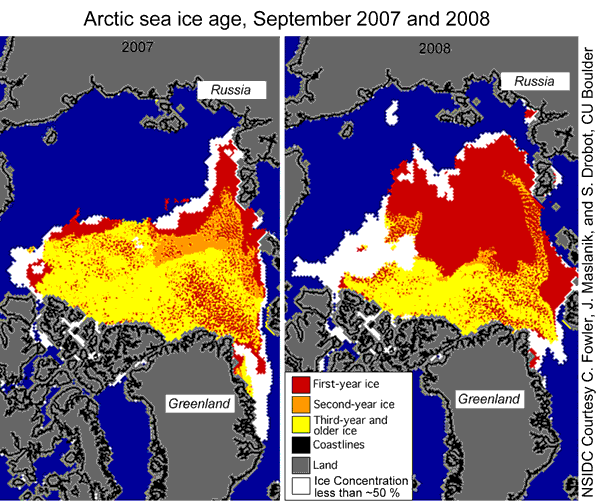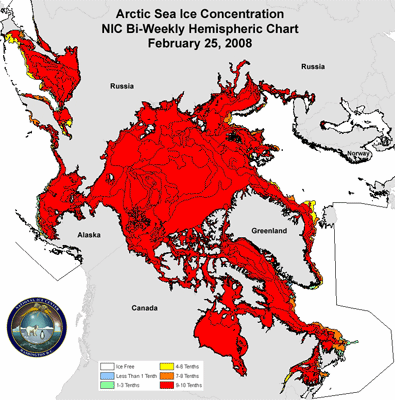 With this summer’s Arctic sea ice minimum done and dusted, the first analyses of the season are beginning to appear. The NSIDC’s latest press release suggests that ice volume decline continued:
With this summer’s Arctic sea ice minimum done and dusted, the first analyses of the season are beginning to appear. The NSIDC’s latest press release suggests that ice volume decline continued:
NSIDC Research Scientist Walt Meier said, “Warm ocean waters helped contribute to ice losses this year, pushing the already thin ice pack over the edge. In fact, preliminary data indicates that 2008 probably represents the lowest volume of Arctic sea ice on record, partly because less multiyear ice is surviving now, and the remaining ice is so thin.â€
Click on the thumbnail above to see the big picture on multi-year ice reduction. The large area of red first year ice will obviously become second year ice next year, but the continuing reduction in thicker, older ice sets the stage for further big losses the next time the Arctic has a warm summer. The European Space Agency confirms this, quoting US National Ice Centre Chief Scientist Dr Pablo Clemente-Colón:
Although last year’s summer sea ice minimum extent record was not broken, a record amount of the thickest multiyear sea ice was actually lost this season impacting the thickness of the sea ice presently found around the North Pole region and setting the stage for more minimum or near-minimum records in upcoming years.
The ESA also provide some nice images…

This ESA composite shows the 2007 minimum (in brown) overlaid on the 2008 minimum, while this NIC animation illustrates the pattern of ice loss through the season:

Also up north, new analysis of data from the GRACE satellite for Greenland shows that the warm summer of 2007 caused a loss of 350 cubic kilometres of ice, a large increase over the 2003-8 average of 195 km3 (paper available to AGU members here). If that’s what one warm summer can do, what will happen as the sea ice decline continues? The implications for sea level rise are obvious enough (195 km3 is roughly equal to 0.5mm SLR).
Worth noting: a new paper by David Holland at New York University suggests that the rapid thinning of Greenland’s largest glacier, the Jakobshaven Isbrae, in 1997 was caused by subsurface ocean warming. A similar effect could be at work around West Antarctica…

Phew, that’s a relief “subsurface ocean warming”…must be those pesky volcano’s again…at least we know it’s not AGW!